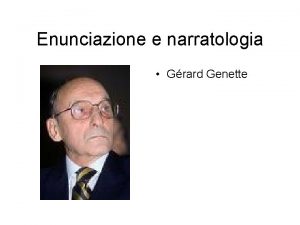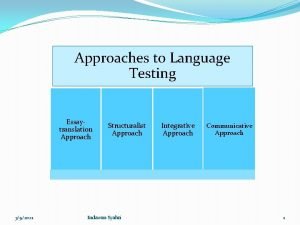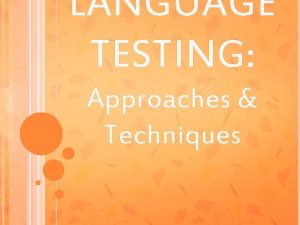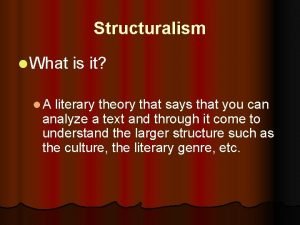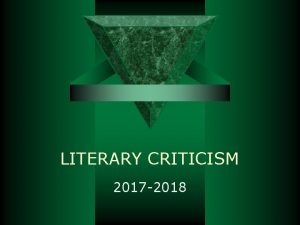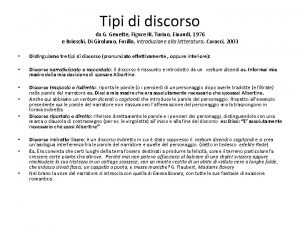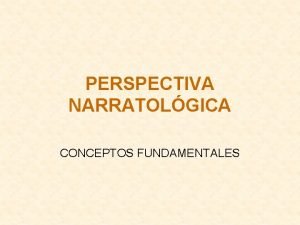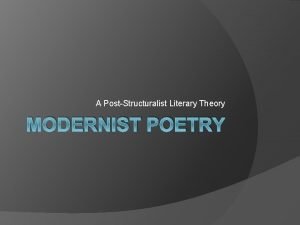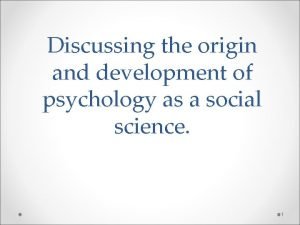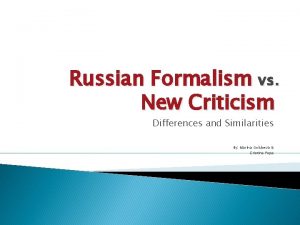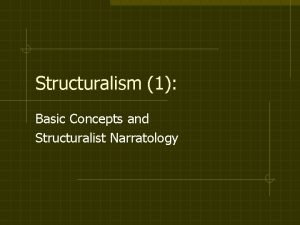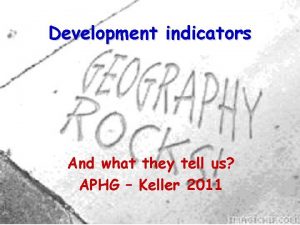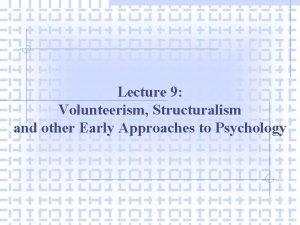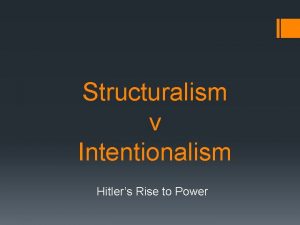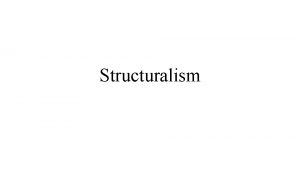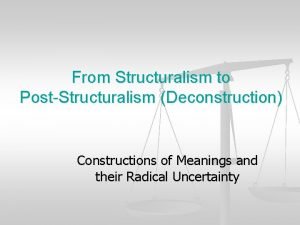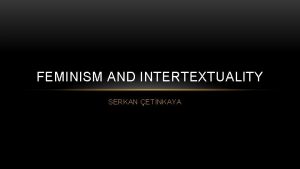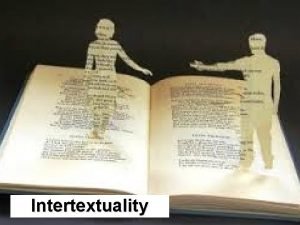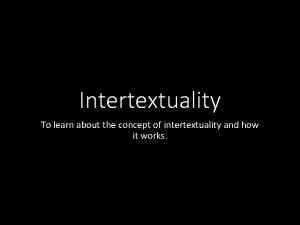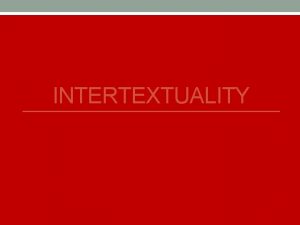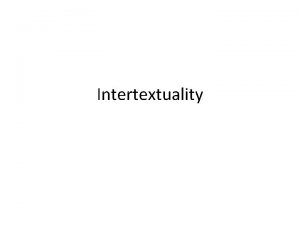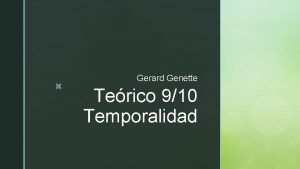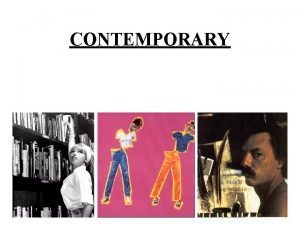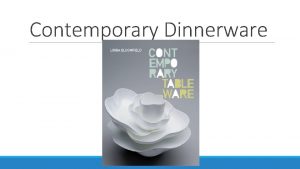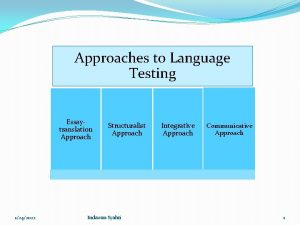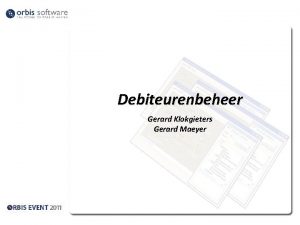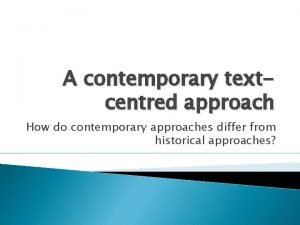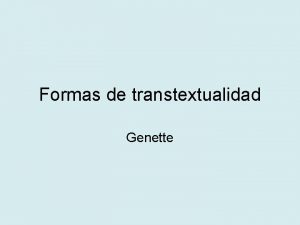Gerard Genette A structuralist approach to Intertextuality contemporary























- Slides: 23

Gerard Genette: A structuralist approach to Intertextuality �contemporary French theorist and critic �Structuralists refocus their attention away from the details of individual works to the systems out of which they have been constructed.

�Genette is not concerned with individual symbols or individual works, but with the way in which signs and texts function within and are generated by describable systems, codes, cultural practices, and rituals.

�Genette focuses the major part of his studies on the nature of narrative discourse and especially narrative fiction.

�. In his trilogy, composed of The Architect: An Introduction (1992), Palimpsests(a written document usually on parchment that has been written upon several times): Literature in the Second Degree (1997 a), and Paratexts: Thresholds of Interpretation (1997 b), Genette produces a coherent theory and map of what he terms “transtextuality, ” which can be translated as a structuralist approach to intertextuality.

5 Types of transtextuality � 1 - Intertextuality � 2 -Paratextuality � 3 -Metatextuality � 4 -Hypertextuality � 5 -Architextuality

�Transtextuality �“All that which puts one text in relation, whether obvious or concealed, with other texts. ” Gerard Genette

Based on �Mikhail Bakthin’s concepts of “diagolism” and “heteroglossia” �Julia Kristeva’s “intertextuality”: ”mosaic of citations” that constitute a text.

INTERTEXTUALITY �“The effcetive co-presence of two texts” in the form of quotation(explicit), plagiarism or allusion(imlicit) “I was surprised his nose was not growing like Pinocchio’s. ” “When she lost her job, she acted like a Scrooge, and refused to buy anything that wasn’t necessary. ”

PARATEXTUALITY �The relation between the text and its paratext �(titles, prefaces, dedications…) �The paratext marks the elements which lie on the threshold of the text and which help to direct and control the reception of a text by its readers. -para: beside

�Threshold consists of a Peritext: titles, chapter titles, prefaces and notes Epitext consisting of elements- such as interviews, publicity announcements, reviews by and adresses to critics, private letters and other authorial and editorial discussions- “outside” of the text in question

�Paratext: Peritext+Epitext

�The paratext performs various functions which guide the text’s readers and can be understood pragmatically in terms of various simple questions, all concerned with the manner of the texts existence: when published? By whom? For what purpose?

Major peritextual field �Dedications �Inscriptions �Epigraphs �Prefaces can have major effects upon the interpretation of a text

Genette asserts that � the single most important aspect of paratextuality is “to ensure for the text a destiny consistent with the authors purpose” �Function privileged at the expense of intention

METATEXTUALITY �“the critical relationship par excellence”, works where a text “makes comments” about another one. (commentary) �Metatextual relationship can act in explaining, denying or approving of text 1. For example, different kinds of Holy Books' interpretations are interpretation, explanation and description. �Metatextuality plays a significant role in establishing the "reputation" of a writer.

HYPERTEXTUALITY �The relationship between one text (the hypertext) to an anterior text (hypotext), which the former transforms or modifies. (parody, sequel) �A hypertext is the continuing and unconcluded meaning of its hypotext. A hypertext is the future of meaning of its hypotext. The meaning of a hypotext is incomplete without the hypertext that it generates. A hypertext and its hypotext are a sign of the past and the present as a unity of meaning. A hypertext is proof that the past is endless. Intertextuality is a sublime "conversation of time" with a distinct hint of immortality. Texts are not immortal.

�Palimsests involves “any relationship uniting a text B (hypertext) to an earlir text A (hypotext), upon which it is grafted in a manner that is not that of commentary” �The term labeled as hypotext iss termed by most other critics the inter-text, a text which can be definitely located as a major source of signification of a text.

�the meaning of hypertextual works depends upon the readers knowledge of the hypotext which the hypertext either satirically transforms or imitates for the purpose of pastiche. �Texts can be transformed by processes of self expurgation excision, reduction, amplification …

�Hypertext Hypotext �The Hours (1998) Michael Cunningham Mrs. Dalloway (1925) Virginia Woolf �The Rings of Saturn (1995) W. G. Sebald Urn Burial (1685) Thomas Brown �Last Orders (1996) Graham swift As I lay Dying (1931) William Faulkner

�Self expurgation: differences between the first serialized version and the final published edition of Thomas Hardy’s Tess of the D’Urbervilles. �Excision and reduction: versions of Shakespeare or popular novels which Victorian publishers often published minus the in appropriate or religiously controversial bits �Amplifications: hypotexts can go through process of expansion, as in Thomas Mann’s Joseph and his Brothers, which amplifies a Biblical hypotex of approximately 26 pages to a novel of approximately 1600 pages �Transmotivization: Hypertexts can give a character motivations lacking the hypotext, as in the example of prince of Exgypt.

�Genette seeks merely to explore the ways in which texts are read in relation to the other texts.

ARCHITEXTUALITY �Architextuality “the entire set of general or transcendent categories-types of discourse, modes of enunciation, literary genres-from which emerges each singular text”. �Genette calls architextuality, the relationship between a work and the genre that work belongs to it. Also, architextuality is the tradition or pool of texts out of which a text of the present emerges. Just as an utterance is an actual realization (parole) of the code of a language (langue), similarly any literary text originates out of a tradition of text.

paratextuality is a text in which we are influenced by items which are not in the text themselves, such as titles; metatextuality which is about to citing of another works’ texts in a different text; architextuality which is about a text by title; and hypertextuality which includes something like translation and adaptation which is limited to a text, but also to film, painting, and even music.
 Focalizzazione mista
Focalizzazione mista Kind of intertextuality
Kind of intertextuality Genette palimpsestos
Genette palimpsestos Structuralist approach in language testing
Structuralist approach in language testing The essay-translation approach
The essay-translation approach What is structuralism
What is structuralism What is structuralist formalist
What is structuralist formalist Monologo interiore e flusso di coscienza
Monologo interiore e flusso di coscienza Narrador genette
Narrador genette Informational and behavioral control
Informational and behavioral control Principles of management by stephen robbins 13th edition
Principles of management by stephen robbins 13th edition Post structuralist poetry
Post structuralist poetry Structuralist
Structuralist History and origin of science of psychology slideshare
History and origin of science of psychology slideshare Differentiate formalism from romanticism
Differentiate formalism from romanticism Structuralist narratology
Structuralist narratology Edward b titchener structuralism
Edward b titchener structuralism Structuralist theory aphg
Structuralist theory aphg Structuralism psychology
Structuralism psychology Post structuralism literary theory
Post structuralism literary theory Structuralism vs intentionalism
Structuralism vs intentionalism Structuralism literature
Structuralism literature Structuralism post structuralism and deconstruction
Structuralism post structuralism and deconstruction Intertextuality nedir
Intertextuality nedir
